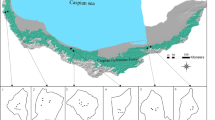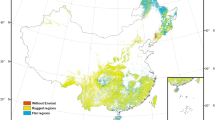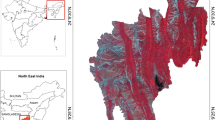Abstract
Being able to accurately estimate and map forest biomass at large scales is important for a better understanding of the terrestrial carbon cycle and for improving the effectiveness of forest management. In this study, forest plot sample data, forest resources inventory (FRI) data, and SPOT Vegetation (SPOT-VGT) normalized difference vegetation index (NDVI) data were used to estimate total forest biomass and spatial distribution of forest biomass in northeast China (with 1 km resolution). Total forest biomass at both county and provincial scales was estimated using FRI data of 11 different forest types obtained by sampling 1156 forest plots, and newly-created volume to biomass conversion models. The biomass density at the county scale and SPOT-VGT NDVI data were used to estimate the spatial distribution of forest biomass. The results suggest that the total forest biomass was 2.4 Pg (1 Pg = 1015 g), with an average of 77.2 Mg ha−1, during the study period. Forests having greater biomass density were located in the middle mountain ranges in the study area. Human activities affected forest biomass at different elevations, slopes and aspects. The results suggest that the volume to biomass conversion models that could be developed using more plot samples and more detailed forest type classifications would be better suited for the study area and would provide more accurate biomass estimates. Use of both FRI and remote sensing data allowed the down-scaling of regional forest biomass statistics to forest cover pixels to produce a relatively fine-resolution biomass map.





Similar content being viewed by others
References
Anaya JA, Chuvieco E, Palacios-Orueta A (2009) Above-ground biomass assessment in Colombia: a remote sensing approach. For Ecol Manag 257:1237–1246
Blackard JA, Finco MV, Helmer EH, Holden GR, Hoppus ML, Jacobs DM, Lister AJ, Moisen GG, Nelson MD, Riemann R, Ruefenacht B, Salajanu D, Weyermann DL, Winterberger KC, Brandeis TJ, Czaplewski RL, McRoberts RE, Patterson PL, Tymcio RP (2008) Mapping US forest biomass using nation wide forest inventory data and moderate resolution information. Remote Sens Environ 112:1658–1677
Botkin DB, Simpson LG (1990) Biomass of the North-American boreal forest: a step toward accurate global measures. Biogeochemistry 9:161–174
Boyd DS, Foody GM, Curran PJ (1999) The relationship between the biomass of Cameroonian tropical forest and radiation reflected in middle infrared wavelength. Int J Remote Sens 20(5):1017–1023
Brown S (2002) Measuring carbon in forests: current status and future challenges. Environ Pollut 116:363–372
Brown SL, Schroeder PE (1999) Spatial patterns of aboveground production and mortality of woody biomass for eastern U.S. forests. Ecol Appl 9:968–980
Brown SJ, Gillespie R, Lugo AE (1989) Biomass estimates for tropical moist forests of Brazilian Amazon. Interciencia 17:8–18
Chen XL (2003) The distribution patterns and modeling of biomass and net primary production in China main forests. Doctor of Philosophy Thesis, Beijing Forestry University, Beijing, China (in Chinese)
Chen CG, Guo XF (1986) Mathematical models for predicting broadleaved-Korean pine mixed forest biomass. J Liaoning For Sci Technol 3:27–37 (in Chinese)
Dixon RK, Brown S, Houghton RA, Trexier MC, Winsniewski J (1994) Carbon pools and flux of global forest ecosystems. Science 263:185–190
Du L, Zhou T, Zou ZH, Zhao X, Huang KC, Wu H (2014) Mapping forest biomass using remote sensing and national forest inventory in China. Forests 5:1267–1283
EBVMC (Editorial Board of Vegetation Map of China, Chinese Academy of Sciences) (2001) Vegetation Atlas of China. Science Press, Beijing (in Chinese)
Fang JY, Wang GG, Liu GH, Xu SL (1998) Forest biomass of China: an estimate based on the biomass-volume relationship. Ecol Appl 8(4):1984–1991
Fang JY, Chen AP, Peng CH, Zhao SQ, Ci LJ (2001) Changes in forest biomass carbon storage in China between 1949 and 1998. Science 292:2320–2322
González-Alonso F, Merino-De-Miguel S, Roldán-Zamarrón A, García-Gigorro S, Cuevas JM (2006) Forest biomass estimation through NDVI composites. The role of remotely sensed data to assess Spanish forests as carbon sinks. Int J Remote Sens 27:5409–5415
Holben BN (1986) Characteristics of maximum-value composite images for temporal AVHRR data. Int J Remote Sens 7:1435–1445
Houghton RA, Lawrence KT, Hackler JL, Brown S (2001) The spatial distribution of forest biomass in the Brazilian Amazon: a comparison of estimates. Glob Change Biol 7:731–746
Jiao Y, Hu HQ (2005) Carbon storage and its dynamics of forest vegetations in Heilongjiang Province. Chin J Appl Ecol 16(12):2248–2252 (in Chinese)
Kramer PJ (1982) Carbon dioxide concentration, photosynthesis, and dry mater production. Bioscience 31:29–33
Le Toan T, Quegan S, Davidson MWJ, Balzter H, Paillou P, Papathanassiou K, Plummer S, Rocca F, Saatchi S, Shugart H, Ulander L (2011) The BIOMASS mission: mapping global forest biomass to better understand the terrestrial carbon cycle. Remote Sens Environ 115:2850–2860
Li HK, Lei YC (2010) Estimation and evaluation of forest biomass carbon storage in China. Chinese Forestry Publishers, Beijing (in Chinese; Manag 222, 191–201)
Liu J, Liu S, Loveland TR (2006) Temporal evolution of carbon budgets of the Appalachian forests in the U.S. from 1972 to 2000. For Ecol Manag 222:191–201.
Liu C, Zhang LJ, Li FR, Jin XJ (2014) Spatial modeling of the carbon stock of forest trees in Heilongjiang Province, China. J For Res 25(2):269–280
Lu DS (2007) The potential and challenge of remote sensing-based biomass estimation. Int J Remote Sens 27:1297–1328
Lu DS, Mausel P, Brondizio ES, Moran E (2004) Relationships between forest stand parameters and Landsat Thematic Mapper spectral responses in the Brazilian Amazon basin. For Ecol Manag 198:149–167
Luo T (1996) Research on carbon sequestration functions of main forest types in northern China. Doctor of Philosophy Thesis, Chinese Academy of Sciences, Beijing, China, p 211 (in Chinese)
Melillo JM, Steudler PA, Aber JD, Newkirk K, Lux H, Bowles FP, Catricala C, Magill A, Ahrens T, Morrisseau S (2002) Soil warming and carbon cycle feedbacks to the climate system. Science 298:2173–2176
Myneni RB, Hall FG, Sellers PJ, Marshak AL (1995) The interpretation of spectral vegetation indexes. IEEE Trans Geosci Remote Sens 33:481–486
Pan YD, Luo TX, Birdsey R, Hom J, Melillo J (2004) New estimates of carbon storage and sequestration in China’s forests: effects of age-class and method on inventory-based carbon estimation. Clim Change 67:211–236
Phillips OL, Malhi Y, Higuchi N, Laurance WF, Nunez PV, Vasquez RM, Laurance SG, Ferreira LV, Stern M, Brown S, Grace J (1998) Changes in the carbon balance of tropical forests: evidence from long-term plots. Science 282:440–442
Prince SD, Goward SN (1995) Global primary production: a remote sensing approach. J Biogeogr 22:815–835
Ren Y, Chen SS, Wei XH, Xi WM, Luo YJ, Song XD, Zuo SD, Yang YS (2016) Disentangling the factors that contribute to variation in forest biomass increments in the mid-subtropical forests of China. J For Res 27(4):919–930
Running SW, Justice CO, Salomonson V, Hall D, Barker J, Kaufmann YJ, Strahler AH, Huete AR, Muller JP, Vanderbilt V, Wan ZM, Teillet P, Carneggie D (1994) Terrestrial remote sensing science and algorithms for EOS/MODIS. Int J Remote Sens 15:3587–3620
Smith JE, Heath LS, Jenkins JS (2003) Forest volume to biomass models and estimates of mass for live and standing dead trees of U.S. forests. [EB/OL], 17 Oct 2010. http://www.arborsearch.fs.fed.us/pubs/5179
Sun YH, Meng L, Tian L, Li GL, Sun OJ (2016) Assessing current stocks and future sequestration potential of forest biomass carbon in Daqing Mountain Nature Reserve of Inner Mongolia, China. J For Res 27(4):931–938
Tan K, Piao SL, Peng CH, Fang JY (2007) Satellite-based estimation of biomass carbon storages for northeast China’s forests between 1982 and 1999. Forest Ecol Manage 240:114–121
Tucker CJ, Sellers PJ (1986) Satellite remote sensing of primary production. Int J Remote Sens 7(11):1395–1416
Wang XJ, Huang GS, Sun YJ, Fu X, Han AH (2008) Forest carbon storage and dynamics in Liaoning Province from 1984 to 2000. Acta Ecol Sin 28(10):4757–4764 (in Chinese)
Wang YF, Liu L, Shangguan ZP (2017) Dynamics of forest biomass carbon stocks from 1949 to 2008 in Henan Province, east-central China. J For Res. https://doi.org/10.1007/s11676-017-0459-7 (published online)
West PW (2004) Arbor and forest measurement. Springer, Berlin
Woodwell GM, Whittaker RH, Reiners WA, Likens GE, Delwiche CC, Botkin DB (1978) The biota and the world carbon budget. Science 199:141–146
Wulder MA, White JC, Fournier RA, Luther JE, Magnussen S (2008) Spatially explicit large area biomass estimation: three approaches using forest inventory and remotely sensed imagery in a GIS. Sensors. 8:529–560
Xu XL, Cao MK, Li KR (2007) Temporal spatial dynamics of carbon storage of forest vegetation in China. Prog Geog 26(6):1–10 (in Chinese)
Yemshanov D, McKenney DW, Pedlar JH (2012) Mapping forest composition from the Canadian National Forest Inventory and land cover classification maps. Environ Monit Assess 184:4655–4669
Zhang XY, Kondragunta S (2006) Estimating forest biomass in the USA using generalized allometric models and MODIS land products. Geophys Res Lett 33:1–5
Zhang J, Huang S, Hogg EH, Lieffers V, Qin Y, He F (2014) Estimating spatial variation in Alberta forest biomass from a combination of forest inventory and remote sensing data. Biogeosciences 11:2793–2808
Zhao M, Zhou GS (2004) Forest inventory data based biomass models and their prospects. Chin J Appl Ecol 15(8):1468–1472 (in Chinese)
Zheng DL, Rademacher J, Chen JQ, Crow T, Bresee M, Le Moine J, Ryu S-R (2004) Estimating aboveground biomass using Landsat 7 ETM+ data across a managed landscape in northern Wisconsin, USA. Remote Sens Environ 93:402–411
Author information
Authors and Affiliations
Corresponding authors
Additional information
Project funding: This study was supported by the National Natural Science Foundation of China (No. 41401500), the National Key Technologies R&D Program of China (2012BAD22B04), the China Postdoctoral Science Foundation (2015M580629, 2016M590679), the Key Scientific Research Projects of Higher Education of Henan Province, China (16A420003, 17A420001), Scientific and Technological Innovation Team of Universities in Henan Province, China (18IRTSTHN008 ), Funds for Fundamental Scientific Research in Colleges in Henan Province, China (NSFRF1630) and Innovation Research Team of Henan Polytechnic University, China (B2017-16) and the China Coal Industry Association Guidance Program (MTKJ-2015-285).
The online version is available at http://www.springerlink.com
Corresponding editor: Tao Xu.
Rights and permissions
About this article
Cite this article
Wang, X., Wang, S. & Dai, L. Estimating and mapping forest biomass in northeast China using joint forest resources inventory and remote sensing data. J. For. Res. 29, 797–811 (2018). https://doi.org/10.1007/s11676-017-0504-6
Received:
Accepted:
Published:
Issue Date:
DOI: https://doi.org/10.1007/s11676-017-0504-6




